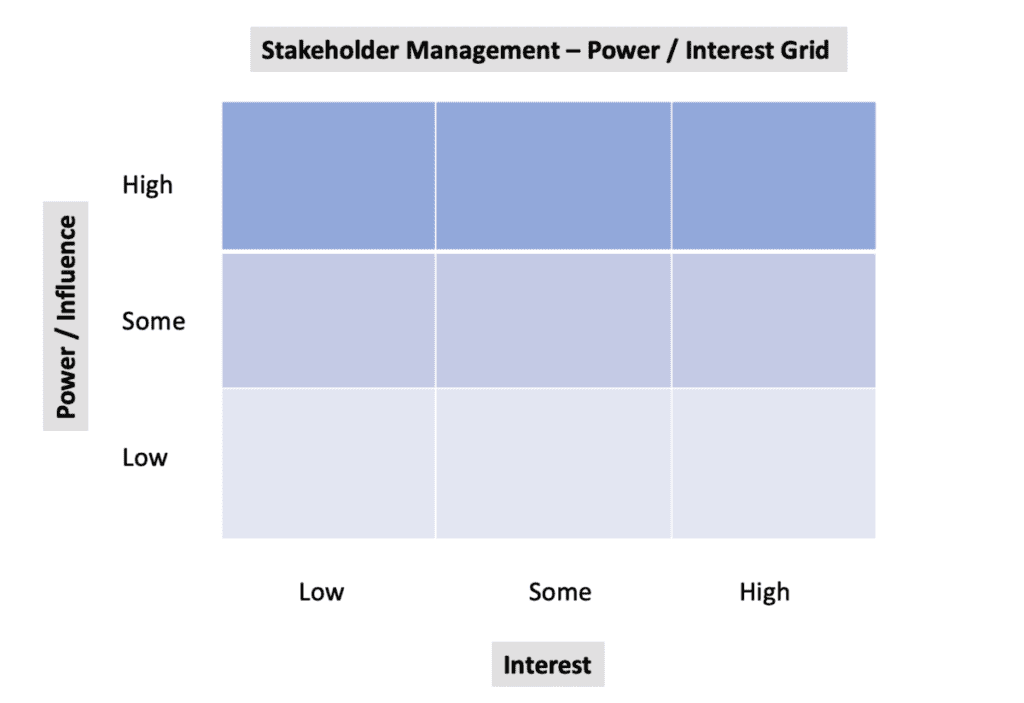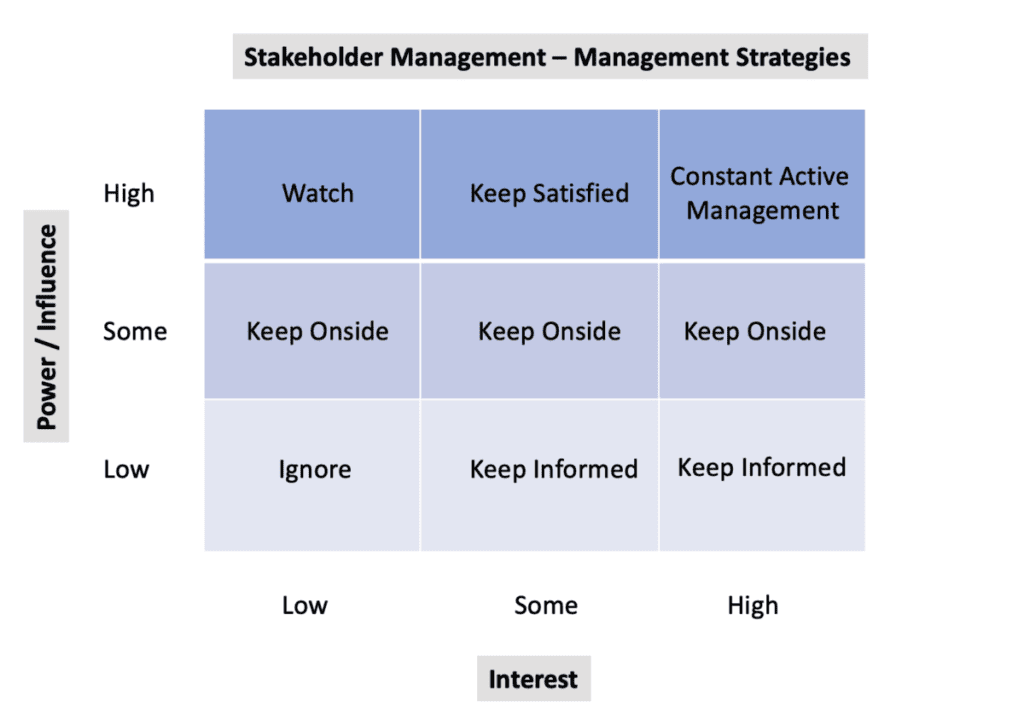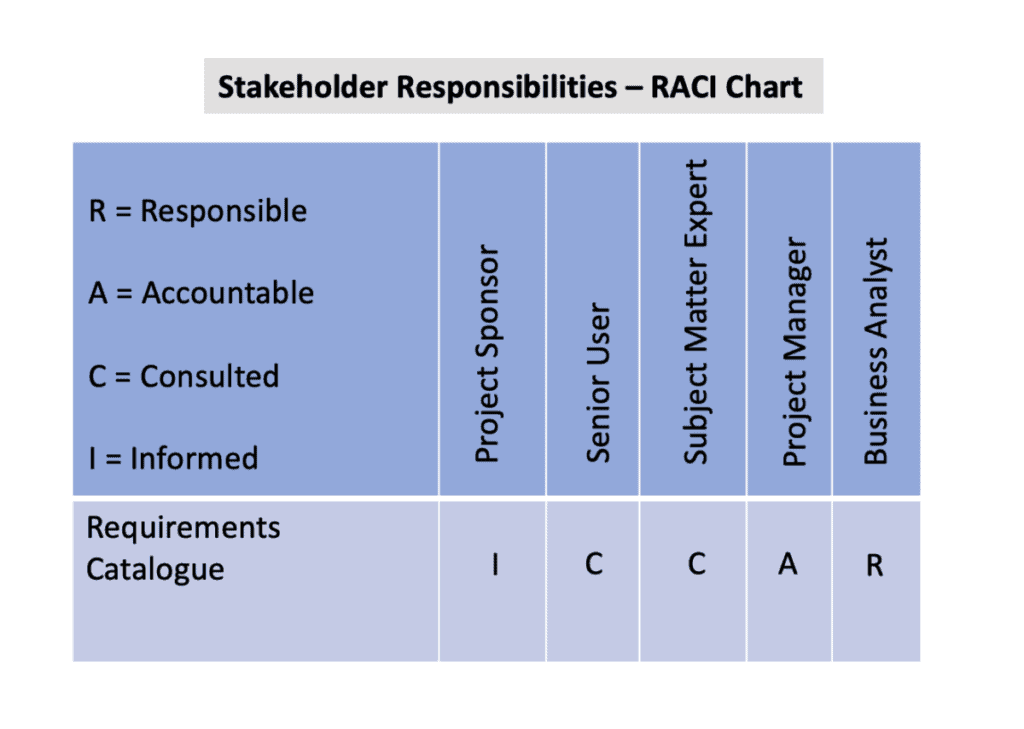Effective stakeholder management is critical to the success of programmes, projects and business initiatives. Whilst stakeholders will be identified during initiation, it is important that the list of stakeholders and the management of stakeholders is revisited as time goes on during the programme, project or business initiative.
Table of Contents
What is meant by a Stakeholder?
A working definition of a stakeholder
Is anyone who has an interest in or may be affected by the problem under study is considered a stakeholder. More or less, it means anyone who might influence the project.
A stakeholder can be internal or external to the business and may be an individual or an organisation.
Stakeholder Categories
In a particular programme, project or a business initiative, stakeholders can be identified at different levels. Identified stakeholders can be grouped in categories as follows to help with stakeholder management:
- Customers – These are the people or organisations for whom the organisation provides goods or services.
- Partners – These are organisations that work on behalf of an organisation or provide specialised services to it.
- Suppliers – They are the organisation’s primary source of inventory and purchasing. Unlike financial transactions, these provide a company with resources for which it pays.
- Regulators – Many businesses are now subject to government rules and external inspections.
- Employees – Employees in an organisation have a vested interest in how it is run and the changes it makes.
- Managers – They supervise the group, while it is in operation. They are also executive managers of other businesses.
- Owners – Ownership of a commercial business is typically held by the individuals who operate it directly.
- Competitors – Competitors compete with the organisation, and they have a strong passion for any modifications made by the firm.
There may well be other types of stakeholders (or a refinement of certain groups) depending upon your organisation context and its business model.
Stakeholder Map
A stakeholder map is a useful tool used to visualise and document relationships between stakeholders and can aid stakeholder management.

There are many benefits to taking the time to understand your stakeholders and develop a stakeholder map to aid with stakeholder management.
Some of the benefits include:
- Improved communication between project team members and stakeholders
- Greater clarity around roles and responsibilities
- Better identification of potential risks and issues
- Improved decision making
- Increased likelihood of project success
Stakeholder Power / Interest Grid
The power / interest grid offers a useful technique for analysing stakeholders (and aiding stakeholder management). By taking the time to understand stakeholders, you can ensure that they are kept informed and engaged throughout the project. This will help to keep the project on track and prevent any problems from arising.
The grid is a simple way of understanding which stakeholders need to be kept happy, and which ones could potentially cause problems.

The power/interest grid:
- Low Power, Low Interest – These stakeholders are not likely to resist change or try to influence it. They may, however, need reassurance that the project is proceeding as planned and will not negatively impact them.
- High Power, Low Interest – These stakeholders have the ability to derail your project but are generally uninterested in it. It is important to keep them updated on your project’s progress and ensure that they understand how it may impact them.
- Low Power, High Interest – These stakeholders are interested in the project but do not have the ability to influence it. They should be kept informed of the project’s progress and given opportunities to provide feedback.
- High Power, High Interest – These are the most important stakeholders and should be engaged throughout the project.

Once you have identified stakeholders, it is important to understand their interests and how they might be impacted by the project. This will help you to develop strategies for a stakeholder management plan for engaging with them and keeping them updated on the project’s progress.
It is also important to keep an eye on changes in the power and interest of your stakeholders. As the project progresses, some stakeholders may become more or less interested or powerful. This could impact their ability to influence the project, and so it is important to monitor these changes and adjust your engagement strategies accordingly.
Stakeholder Mapping Template
A stakeholder mapping template provides a means of documenting stakeholders and related categories in their own right.
- Type – defines whether they are internal or external
- Category – the grouping of stakeholders in the context of the programme, project or business initiative
- Stakeholder – named stakeholders.
- Description – provides a definition of the names stakeholder
A stakeholder map template can be a helpful tool when creating a stakeholder map. The template can help to ensure that all of the relevant information is included and that the map is organised in a way that is easy to understand.

Some of the things that you may also want to include in your stakeholder map template include:
- The purpose and scope of the stakeholder mapping exercise.
- A list of all stakeholders, including those who may be opposed to the project.
- The level of influence and interest for each stakeholder.
- A review and update schedule.
By including all of this information in a stakeholder mapping template, you can create a comprehensive stakeholder map
Principles of Stakeholder Mapping
There are a few key principles that should be followed when creating a stakeholder map. Some of the key principles include:
- Define the purpose and scope of the stakeholder mapping exercise – before starting any mapping exercise, it is important to define the purpose and scope. This will help to ensure that the mapping exercise is focused and relevant.
- Identify all stakeholders – It is important to identify all stakeholders, including those who may be opposed to the project. This will help to ensure that everyone is considered and that potential risks are identified.
- Assign level of influence and interest – once all stakeholders have been identified, it is important to assign a level of influence and interest. This will help to prioritise communications and identify who should be involved in decision making.
- Review and update regularly – it is important to review and update the stakeholder map on a regular basis. This will ensure that it remains accurate and relevant.
By taking the time to understand your stakeholders and develop a stakeholder map, you can improve communication, identify potential risks, and increase the likelihood of project success.
If you take the time to review and update your stakeholder map on a regular basis, you can ensure that it remains accurate and relevant.
Managing Stakeholders
Once stakeholder positions have been plotted in a power / interest grid, a plan should be drawn up for managing them.
It is also important to manage expectations and ensure that stakeholders understand what they can and cannot expect from the project.
By taking the time to understand your stakeholders and develop a plan for engagement, you can ensure that the project stays on track and that everyone is kept informed. This will help to avoid any problems from arising and will keep the project running smoothly.
The level of engagement required for each stakeholder will be different and will depend on their position on the power/interest grid.
For example, stakeholders who are high power and high interest should be kept engaged throughout the project. This could involve regular updates and meetings to ensure that they are kept up to date with the project’s progress.
Stakeholders who are low power and high interest should also be kept informed of the project’s progress but may not need to be as closely engaged.
Stakeholder Responsibilities: RACI and RASCI Charts
It can be quite useful to support stakeholder management in a business change project to evaluate the job and deliverables, as well as the degree to which stakeholders are involved with them, using a RACI chart.
A RACI chart is a tool used to assign responsibility for tasks or deliverables in a project.
There are four levels of responsibility that can be assigned to a stakeholder:
- R – Responsible – The individual who is responsible for completing the task or deliverable.
- A – Accountable – The individual who is accountable for ensuring that the task or deliverable is completed. This person may not necessarily be responsible for completing the task themselves but they are responsible for ensuring that it is done.
- C – Consulted – The individual who is consulted on the task or deliverable. This person provides input and advice but is not responsible for completing the task.
- I – Informed – The individual who is kept informed of the task or deliverable. This person does not need to be consulted or involved in the task but should be kept up to date on its progress.

When creating a RACI chart, it is important to consider the level of responsibility that each stakeholder has for each task or deliverable. This will help to ensure that everyone understands their role in the project and that the project is completed successfully.
The RACI model can also be expanded to include a fifth level of responsibility, known as the Supervisory level.
The Supervisory level is used to assign responsibility for tasks or deliverables that are not essential to the success of the project but which may be helpful in its completion.
For example, a stakeholder who is responsibleThe RACI model can also be expanded to include an additional level of responsibility, known as the RASCI model.
The RASCI model is often used in conjunction with the RACI model to provide a more comprehensive view of stakeholder responsibility.
Both models are useful tools that can help to ensure that the project is completed successfully and that all stakeholders understand their role in its completion.
Stakeholder Management – Conclusion
It is important to have the right balance between stakeholder management and involvement in order to achieve delivery on cost and time but also to maximise benefit for the organisation and its stakeholders. It is important to maintain open relationships with your stakeholders

